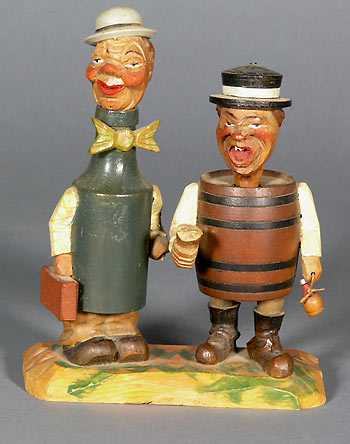At Hearst Museum beer fair, brewing fanatics sample suds and ponder their ancient peers
| 14 October 2009
BERKELEY — Standing outside Hearst Museum of Anthropology on Sunday afternoon, Albany resident Nicholas Farmer minced no words. Oct. 11, 2009 was turning out to be "one of the best days of my life," he said. How so? Getting to talk the fine points of beer and beer-making with like-minded brewing fanatics, without being thought a snob — and sampling the suds of many fine local microbreweries to boot.
 An
Italian beer-barrel figurine holds a bottle-cap lifter,
while a wine-bottle encloses a corkscrew. These items are
part of a current exhibit "99 Bottles of Beer" at
the Hearst Museum, focusing on global brewing traditions since
2,500 B.C.
An
Italian beer-barrel figurine holds a bottle-cap lifter,
while a wine-bottle encloses a corkscrew. These items are
part of a current exhibit "99 Bottles of Beer" at
the Hearst Museum, focusing on global brewing traditions since
2,500 B.C.This beer-lovers' paradise was the Hearst's Beer Symposium and Fair, the third in a series of annual events on the anthropology of food — each involving a museum exhibit, lectures, and a chance to sample the products of many local purveyors. Tea and chocolate were pondered in past years. This time the crowd buzzed gregariously about beer ingredients and fermenting paraphernalia.
Of the five or six beers he imbibed on the patio, Farmer gave top marks to Triple Rock's Chinook Harvest Ale, as "none of the bitter of the hops came through, but all of the flavors" — flavors that reminded him of the hillsides of northern California.
Having sampled the wares, he and other attendees were in high spirits for the subsequent symposium, where a cast of experts followed beer back to its earliest known roots, in ancient Sumeria.
The man whom Farmer called "the godfather of microbrewing" — Fritz Maytag, president and brewmaster at San Francisco's Anchor Brewing Co. — recounted a 1979 research and brewing adventure in which he and colleagues at Anchor, in celebration of their move to a new facility, attempted to recreate, as accurately as possible, the beer made by the Sumerians (in what is now southern Iraq) 4,000 years ago.
After consulting with scholars to figure out the likely ingredients and techniques of the ancients, Anchor brewers crafted a beer made from twice-baked emmer-wheat bread, without boiling or active cooling of the ingredients. Then, with a toast to Ninkasi, Sumerian goddess of beer, they shared the authentic if less-than-delicious brew (drunk from flasks with multiple straws, as depicted on ancient stone tablets) with a convention of fellow brewers. One got a sense of the brewing tradition going back millennia, Maytag said. "It was a magic moment."
(A note to modern microbrew fans: In celebration of the 30th anniversary of the opening of Anchor's current facility, Maytag said the company will release a new brew, called Humming Ale, that will be available locally, on draft, in the next few weeks.)
In a similar vein as Maytag, but from a paleoethnobotanical perspective, Berkeley professor Christine Hastorf described how scientists learn about past societies by analyzing ancient sites and shards for evidence of beer brewing and consumption. Beer can go sour, but no harmful organisms can grow in it — which has made beer, she said, a source of safe nutrients throughout the ages.
That, along with its transformative properties — altering people's mental state, in a social context that knits them together — "makes beer magical to any early society," said Hastorf. To this day, she added, "beer has so much going for it."
For information on visiting the exhibition "99 Bottles of Beer," see the Hearst Museum website.

